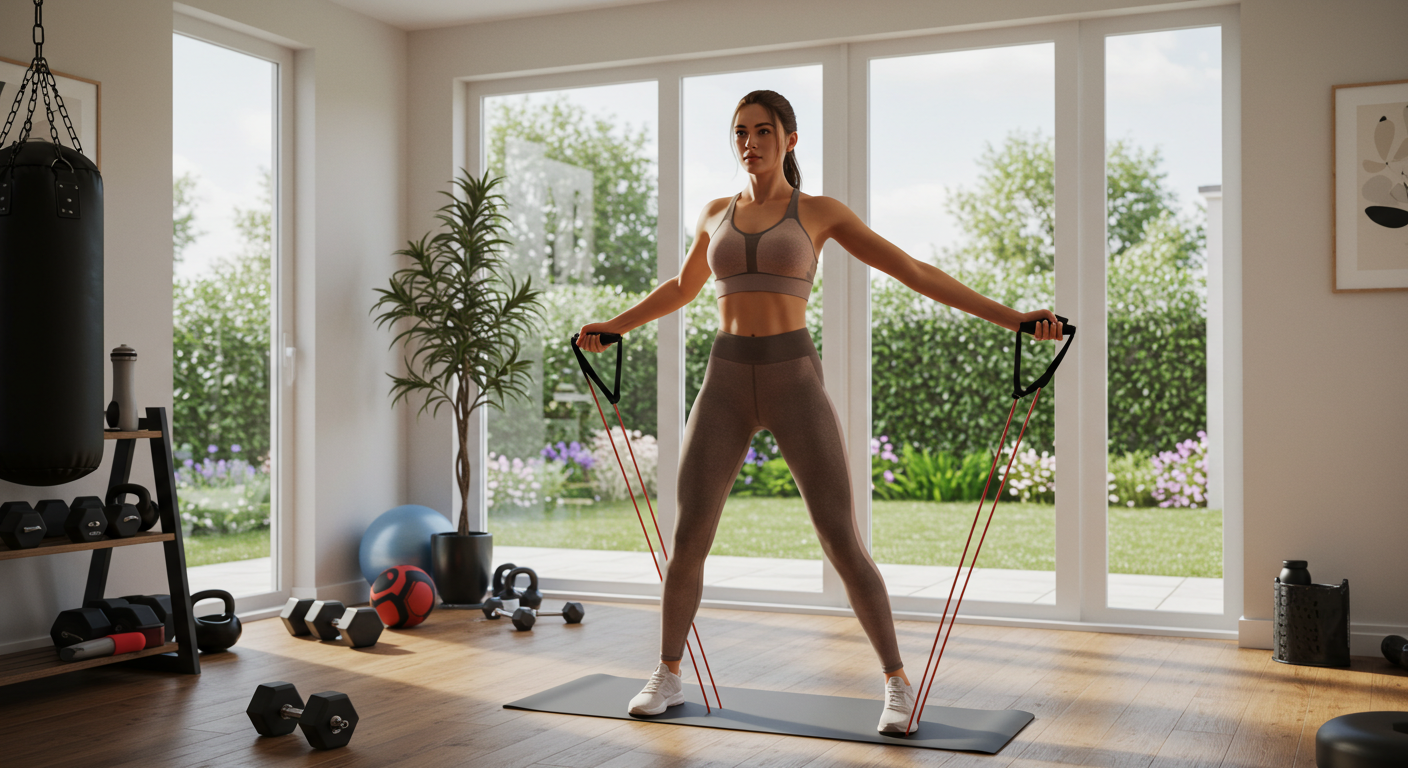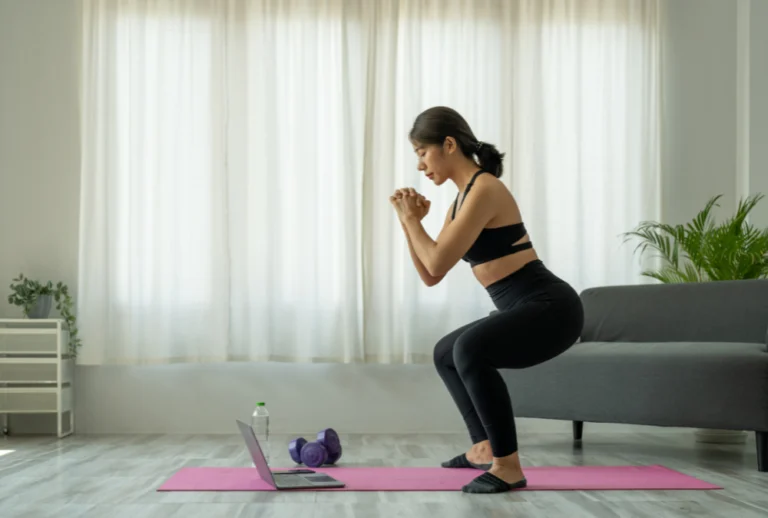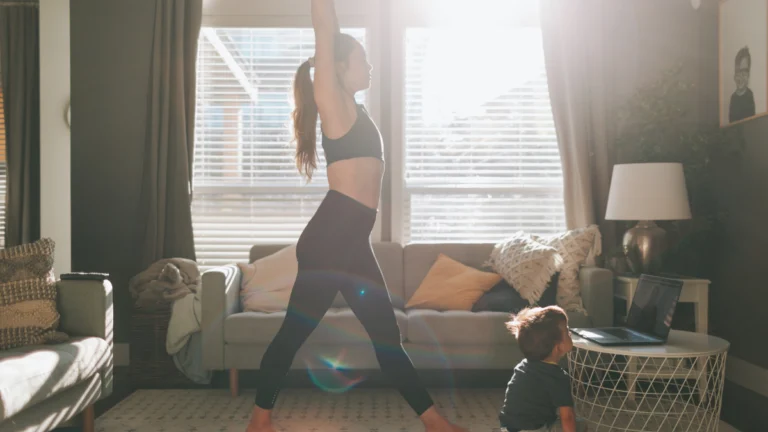Fitness at Home: Unlock Your Fitness Potential

Remember that moment when you almost talked yourself out of exercising? Maybe it was too rainy to drive to the gym… or too late to squeeze in a session after work. What if your best progress could happen right where you are?
We’ve all faced hurdles in staying consistent. That’s why we created this guide – to help you build strength without stepping outside. Whether you’re using a yoga mat in the living room or resistance bands by the stairs, your space can become your sanctuary for growth.
No fancy equipment? No problem. Our approach focuses on what you already have. From quick bodyweight routines to energizing dance sessions, we’ll show you how to craft a plan that fits your life. You’ll discover how small changes – like rearranging furniture for floor exercises – can transform your daily routine.
What makes this journey special? You’re not alone. We’ve combined expert strategies with real success stories from people just like you who are embracing Fitness at Home. Together, we’ll explore creative ways to stay motivated, track progress, and celebrate every victory – big or small.
Key Takeaways
- Build effective routines using everyday spaces and minimal equipment
- Save time and money by avoiding gym memberships
- Access expert-approved methods for all fitness levels
- Mix cardio, strength training, and flexibility exercises
- Join a supportive community cheering for your success
Table of Contents
- Introduction: The Home Fitness Revolution
- Benefits of Exercising at Home
- Getting Started with Fitness at Home
- Essential Home Workout Setup and Equipment
- Beginner Bodyweight Exercises
- Intermediate Home Workouts for Increased Challenge
- Advanced Techniques for High-Intensity Home Training
- Incorporating Fitness Apps and Video Guides
- Structuring Your Home Workout Schedule
- Balancing Exercise with Nutrition and Recovery
- Conclusion
- FAQ
- How can I start exercising at home without equipment?
- What’s the best way to avoid workout plateaus?
- Can home workouts effectively support weight loss?
- How long should a home exercise session last?
- What if I struggle with motivation?
- Are yoga and strength training compatible?
- How do I protect my knees during leg workouts?
- Can I build core strength without crunches?
- What’s the ideal rest period between workouts?
- How do I track progress without gym machines?
Introduction: The Home Fitness Revolution
What if your busiest days could still include effective workouts? Modern life moves fast, but sweat sessions in your living room now rival gym-quality results. From office workers to parents, millions are discovering how strategic movement fits into packed schedules.
Research shows 15-minute workouts boost energy as effectively as longer sessions. Platforms like Orangetheory Fitness stream live classes where you compete with others’ heart rate stats. Even Britain’s NHS Active 10 app proves short bursts add up – no equipment needed.
We’ve seen clients transform kitchens into yoga studios and basements into HIIT zones. One member told us: “I reclaimed 3 hours weekly just by eliminating commute time.” That’s extra moments for family, hobbies, or simply breathing deeper.
Ready to join the movement? This guide breaks down everything from time-crunched routines to creating your perfect workout space. You’ll learn how to:
- Match exercises to your daily rhythm
- Use household items as fitness tools
- Track progress with free apps
Whether you’re squeezing in morning stretches or hosting virtual Zumba parties, your journey starts here. Let’s make every minute count – together.
Benefits of Exercising at Home
Unlocking your body’s potential starts right where you stand. Imagine building full-body strength while brewing morning coffee or improving balance during TV commercial breaks. Consistent movement in familiar spaces creates lasting physical and mental transformations – no commute required.
Take the classic plank: this equipment-free powerhouse activates 20+ muscles simultaneously. One member shared:
“Holding a plank daily fixed my slouched posture better than pricey ergonomic chairs.”
Core engagement from such exercises improves stability during daily tasks – think carrying groceries or playing with kids.
Beyond physical gains, structured routines melt stress. Morning sun salutations calm minds before work emails flood in. Evening resistance sessions release tension accumulated from screen time. You control the clock – squeeze in quick bursts or dive into hour-long flows.
| Home Advantage | Typical Gym Benefit | Impact Difference |
|---|---|---|
| Zero commute time | Average 15-min drive | +50 weekly minutes |
| Personalized music/lighting | Shared environment | +37% enjoyment |
| No membership fees | $40-$200 monthly | +$480 annual savings |
Small victories compound remarkably. Nailing that first 60-second plank or completing three weekly sessions builds visible progress. Over time, these wins rewire self-perception – transforming “I can’t” into “What’s next?”
Getting Started with Fitness at Home
What separates a fleeting workout attempt from lasting results? Clarity and environment. We’ve helped thousands create sustainable routines by pairing purposeful goals with spaces that inspire action – let’s build yours.
Understanding Your Body’s Blueprint
Start by asking: “What makes me feel strongest?” A desk worker might prioritize shoulder mobility, while a parent focuses on knee-friendly movements. Tracking daily patterns reveals where to invest energy. One member realized:
“Morning yoga erased my back pain – now I roll out my mat before checking emails.”
| Goal Type | Sample Objectives | Space Needs |
|---|---|---|
| Mobility Focus | Improve joint range, reduce stiffness | Clear floor area, wall space |
| Strength Building | Increase reps weekly, master push-ups | Sturdy chair, resistance bands |
| Consistency First | 3 weekly sessions, 20 minutes each | Visible calendar, motivational cues |
Crafting Your Movement Sanctuary
Your space should whisper “Let’s move” the moment you enter. Use these strategies:
- Place grippy mats near high-traffic areas
- Store weights at eye level for easy access
- Mark knee-friendly zones with colored tape
Proper flooring protects joints during dynamic exercises. A folded towel under knees during planks prevents bruising. Remember: alignment matters more than intensity. Nail the form first – speed comes later.
Essential Home Workout Setup and Equipment

Ever wonder how a few square feet could become your personal training zone? Your daily routine thrives when your space works smarter – not harder. Let’s transform overlooked corners into energizing movement hubs.
- Grippy mat for stability during dynamic moves
- Resistance bands (light/medium tension)
- Adjustable water bottles as makeshift weights
| Essential Gear | Household Swap | Key Benefit |
|---|---|---|
| Yoga blocks | Stacked books | Supports proper alignment |
| Workout bench | Sturdy chair | Enables incline exercises |
| Knee pads | Folded towels | Protects joints during floor work |
One member shared:
“Using canned goods for arm curls made my day easier – I exercise while prepping dinner!”
Protect your knees by designating carpeted areas for lunges. Place anti-slip mats under high-energy movements. Remember: simplicity fuels consistency.
Rotate equipment weekly to keep your routine fresh. Mondays could focus on band exercises, while Fridays use chair-assisted stretches. Track progress through completed sessions rather than reps – momentum builds confidence.
Your space evolves as you do. That first resistance band? Soon you’ll loop two together for increased challenge. Every day offers new ways to grow stronger right where you are.
Beginner Bodyweight Exercises
What if your strongest workout ally was already within reach? Your body holds untapped potential for building strength – no gear required. We’ve designed these starter moves to fit seamlessly into 10-minute sessions, proving progress happens through smart repetition, not marathon efforts.
Key Exercises to Kickstart Your Routine
Start with three foundational movements each week:
- Chair squats: Lower slowly onto a seat, keeping knees behind toes
- Knee push-ups: Hands wider than shoulders, core engaged
- Wall angels: Slide arms upward while maintaining back contact
| Exercise | Weekly Goal | Heart Rate Boost |
|---|---|---|
| Chair Squats | 3 sets of 12 | +22 bpm average |
| Knee Push-Ups | 2 sets of 8 | +18 bpm average |
| Wall Angels | 4 sets of 10 | Improves circulation |
Tips for Mastering Proper Form
One member shared:
“Focusing on slow movements helped me feel each muscle working – no more neck strain!”
Follow these guidelines:
- Spend 2 minutes warming up wrists and ankles
- Record your first attempts to check alignment
- Rest 45 seconds between sets
Consistency fuels weight loss and heart health gains. Three 15-minute sessions weekly outpace sporadic hour-long workouts. Celebrate small wins – like holding a plank 5 seconds longer – as stepping stones to bigger triumphs.
Intermediate Home Workouts for Increased Challenge

When basic moves start feeling comfortable, your body whispers for new challenges. This phase turns everyday motions into precision tools for sculpting strength and accelerating results. By layering technique onto familiar exercises, you’ll discover fresh ways to push limits while honoring your body’s needs.
Progressing Beyond the Basics
Upgrading your routine isn’t about adding hours – it’s about smarter movement quality. Try alternating forward/backward lunges to engage different muscle fibers. One member noted:
“Adding rotation to my squats made my core work harder than any ab machine!”
| Exercise | Beginner Version | Intermediate Progression |
|---|---|---|
| Push-Ups | Knee position | Elevate feet on stair |
| Squats | Chair-assisted | Single-leg pulses |
| Plank | 30-second hold | Shoulder tap variation |
These tweaks increase calorie burn, supporting weight loss goals through metabolic boosts. Research shows complex body weight exercises torch 30% more calories than static moves – without extra equipment.
Balance intensity with recovery. Alternate high-effort days with active stretching sessions. Track your physical activity patterns to spot improvement trends. Maybe Tuesday’s lunge sets feel smoother than last week’s – that’s progress!
Remember: Sustainable weight loss thrives on consistency, not perfection. Adjust rep counts based on energy levels, and celebrate every new skill mastered. Your strongest self emerges through patient, purposeful challenges.
Advanced Techniques for High-Intensity Home Training
Ready to push past plateaus? Advanced training isn’t about longer sessions – it’s about smarter movement patterns that challenge your muscles in new ways. We’ll guide you through safe progressions that turn living spaces into elite training grounds.
Plyometric Movements for Explosive Power
Plyo exercises like squat jumps and burpees boost fast-twitch muscle fibers – crucial for agility and calorie burn. Start with low-impact versions:
- Box jumps using sturdy stairs
- Lateral bounds over rolled towels
- Explosive push-offs from wall angles
| Plyo Move | Beginner Version | Advanced Progression |
|---|---|---|
| Jump Squats | Quarter-depth jumps | Full-depth with arm swing |
| Mountain Climbers | Slow tempo | Speed bursts (20s on/10s off) |
| Skater Hops | Side taps | Single-leg landings |
Building Core Strength and Stability
True power originates from your center. Try these rotation-based challenges:
- Plank-to-side reach with light water bottle
- Seated Russian twists using a backpack
- Bird-dog variations with 3-second holds
“Focusing on controlled rotations helped me finally master single-arm push-ups!”
Track intensity safely using the talk test – if you can’t speak short phrases, reduce speed. Gradually increase difficulty weekly by adding:
- 1-2 reps per set
- 5° incline on stair exercises
- 2-second pauses at peak contraction
Incorporating Fitness Apps and Video Guides
How do successful exercisers stay motivated without stepping outside? The answer often lives in their pockets. Digital tools now offer personalized coaching, real-time feedback, and community support – transforming screens into 24/7 training partners.
Smart Tracking for Smarter Results
Platforms like Orangetheory Fitness bring gym-quality intensity to living rooms. Their live-streamed classes let you compete with others’ heart rate stats – turning solo sessions into shared victories. One user raved:
“Seeing my calorie burn compared to others keeps me pushing through tough intervals!”
| App Feature | Body Focus | Time Efficiency |
|---|---|---|
| HIIT Timers | Full-body engagement | 20-minute sessions |
| Yoga Libraries | Flexibility & recovery | Customizable durations |
| Form Checkers | Arms/legs alignment | Real-time corrections |
Building Habits Through Guided Journeys
The NHS Active 10 app proves structured programs work. Its bite-sized walking challenges help users gradually increase stamina. Pair this with Couch to 5K’s running plan, and you’ve got a legs-strengthening powerhouse that fits busy schedules.
When choosing tools, consider:
- Your primary goals (weight management, muscle tone, etc.)
- Preferred exercise styles (yoga flows vs. strength circuits)
- Tech compatibility (phone stands for video follow-alongs)
Rotate apps weekly to keep routines fresh. Mondays could focus on arm-sculpting videos, while Fridays explore yoga for stress relief. Remember: The best tool is the one you’ll use consistently – even 10 minutes daily creates ripple effects.
Structuring Your Home Workout Schedule
Ever feel like your schedule works against your best intentions? We’ve found that strategic planning turns sporadic efforts into lasting habits. Start by mapping your energy peaks – maybe mornings spark focus, while evenings allow deeper stretches.
Balance intense sessions with active recovery days. Try this approach:
- Monday/Wednesday: Upper-body circuits with video-guided form checks
- Tuesday/Thursday: Low-impact movement flows for active recovery
- Friday: Full-body challenges focusing on back engagement
| Schedule Type | Time Investment | Key Benefit |
|---|---|---|
| Morning Power | 15-minute bursts | Boosts metabolism |
| Lunch Break Reset | 20-minute flows | Relieves midday tension |
| Evening Unwind | 30-minute stretches | Enhances sleep quality |
One community member shared:
“Using short video tutorials helped me protect my lower back during complex moves – no more next-day aches!”
Set phone reminders for consistency, but stay flexible. Missed a session? A 5-minute movement snack still counts. Pair structured plans with spontaneous activity – dance breaks while cooking or wall-assisted stretches during calls.
Remember: Your strongest routine adapts to life, not the other way around. Track what works, tweak what doesn’t, and celebrate showing up – however it fits your day.
Balancing Exercise with Nutrition and Recovery
Your strongest efforts thrive when three pillars work together: movement, nourishment, and rest. Think of your body as a high-performance engine – it needs quality fuel and regular maintenance to shine. We’ve seen countless people transform results by aligning their plate with their workout mat.
Protein becomes your muscle’s best friend after resistance sessions. Aim for 20-30 grams within two hours of exercise – think Greek yogurt with berries or a turkey wrap. One community member shared:
“Prepping hard-boiled eggs every Sunday stopped my post-workout snack excuses!”
Recovery isn’t just about rest days. Try these paired strategies:
| Focus Area | Nutrition Strategy | Recovery Technique |
|---|---|---|
| Muscle Repair | Lean protein + colorful veggies | Foam rolling before bed |
| Energy Levels | Complex carbs pre-workout | 7-9 hours quality sleep |
| Consistency | Weekly meal prep Sundays | Active stretching breaks |
Busy schedules challenge even the most dedicated people. Keep healthy snacks on your work desk’s side – almonds and baby carrots prevent energy crashes. Hydration matters too: add citrus slices to water for flavor without sugar.
Remember, progress happens when effort and recovery work side by side. Our community swears by “restorative Wednesdays” – lighter workouts paired with extra stretching. Small tweaks create big changes over time.
Need support? Join our virtual cooking demos where trainers and nutritionists share muscle-friendly recipes. Together, we’ll help you build habits that strengthen both body and resolve.
Conclusion
Progress isn’t measured in miles traveled to the gym – it’s found in the consistent choices we make right where we are. Every rep completed, every mindful breath taken, and every modified movement creates ripple effects through your day.
We’ve seen how balance transforms routines from chores into celebrations of capability. Whether using stairs for step-ups or canned goods for resistance, your environment holds endless potential. Start with just 30 seconds of intentional movement – that’s all it takes to spark momentum.
Small shifts create lasting change. Swap scrolling time for wall sits. Turn waiting moments into posture checks. These micro-wins build physical balance while strengthening mental resolve. Our community members prove daily: “You don’t need perfect conditions – just consistent effort.”
Ready to take the next step? Join thousands who’ve found their rhythm through our supportive network. Share victories, ask questions, and discover new ways to thrive – one intentional second at a time. Together, we’ll keep redefining what’s possible.
And to learn more about how to improve your life, check out other articles on TipsAndWellness.com
You can also search for more related content on Healthline.com
FAQ
How can I start exercising at home without equipment?
Begin with bodyweight movements like squats, push-ups, and planks. Use household items like water bottles as light weights or a chair for tricep dips. Focus on mastering form before progressing.
What’s the best way to avoid workout plateaus?
Mix up your routine every 3-4 weeks. Add resistance bands, increase reps, or try advanced variations like jump squats. Apps like Orangetheory Fitness offer guided intensity changes.
Can home workouts effectively support weight loss?
Absolutely! Combine strength training (lunges, mountain climbers) with cardio bursts (jumping jacks, high knees). Pair this with the NHS Active 10 walking program for sustained calorie burn.
How long should a home exercise session last?
Aim for 20-45 minutes daily. Short, focused routines like Couch to 5K intervals often yield better consistency than marathon sessions. Quality over quantity!
What if I struggle with motivation?
Schedule workouts like important meetings. Use video guides from Yoga with Adriene or Fitness Blender for structure. Track progress through photos or a journal.
Are yoga and strength training compatible?
Yes! Yoga enhances flexibility and balance, complementing muscle-building exercises. Try sun salutations for warm-ups or pigeon pose for post-workout recovery.
How do I protect my knees during leg workouts?
Keep knees aligned over ankles during squats/lunges. Add cushioning with yoga mats. If discomfort persists, swap high-impact moves for step-ups or glute bridges.
Can I build core strength without crunches?
Try planks, bird-dogs, or dead bugs. These stabilize your spine while engaging multiple muscle groups. Add instability with a folded towel under hands/feet.
What’s the ideal rest period between workouts?
Allow 48 hours for muscle recovery between strength sessions. Active recovery days could include light yoga or brisk walking. Listen to your body’s signals.
How do I track progress without gym machines?
Monitor reps, hold times (like plank duration), or how clothes fit. Apps like Strong or MyFitnessPal help log achievements and nutrition.
Discover more from Tips and Wellness
Subscribe to get the latest posts sent to your email.



